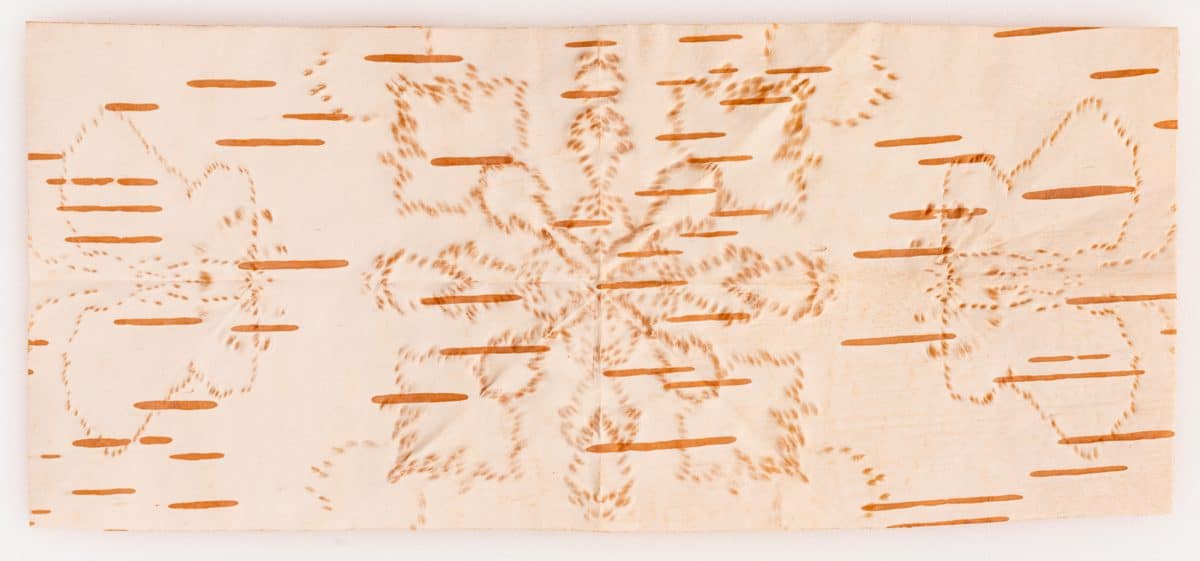Several types of birch trees are indigenous to North America’s Eastern Woodlands area and the Great Lakes. Nishnabé people use their wood for many different facets of everyday life, such as making canoes, wigwams, basketry, and art, including birch bark biting. Some of these date back centuries since they arrived in the area.
“Birch bark is one of the most versatile and most beautiful trees,” said Gun Lake Potawatomi Tribe citizen Kelly Church. She discussed birch bark biting during a webinar in early October as part of the Collections Spotlight program from the Coe Center for the Arts in Santa Fe, New Mexico. Church has harvested bark on her own for decades, with basketry as her primary art form.

Collecting supplies
She enjoys birch bark biting for the uniqueness of the creativity it requires. Artists create images — inspired by oral traditions, animals, other natural elements and more — with their teeth. The process all starts with picking the right piece of material.
“Winter bark” is darker and more challenging to harvest, whereas “summer bark” is lighter with almost a yellow tone. Harvesters collect it without harming the trees during a short period that comes in late June and early July, usually at the same time berries ripen. Church described the bark as popping off the surface of the tree trunk.
“It will not come off unless it’s ready to come off,” she said.
“You’ll see the layers coming up. It’s kind of telling you, ‘I’m ready to be picked.’”
She reinforced the importance of never forcing the bark off the tree and not collecting more than needed.
According to Church, once separated from the trunk, the layers peel back from each other “like an onion.” They continue to get thinner and thinner as they curl away from one another. Pliable sheets a little thicker than paper are ideal for biting.
Methods and practice
Creating symmetrical art in this form requires a specific technique. First, fold a thin piece of bark in half like a book, then fold it from top to bottom. Third, fold the sheet corner to corner, creating a triangle. Use the canine tooth of the upper jaw — also known as the eyetooth — to bite a pattern into the bark while moving it around to craft the image.
During the webinar, Church closed her eyes as she began to demonstrate the technique on a spare piece of bark in her studio. “I can’t look at people when I bite,” she said and laughed.
After a few moments, Church unfolded it back into a single sheet.
“You have to open it very carefully,” she said. “As you open it, you’ll see I have a circle. For me, this is the beginning of a turtle.”
Church creates several animals and symbols on demand due to repetition throughout the years; otherwise, she practices to achieve additional requests.
Nishnabé people still carry on the rare art form through oral tradition like many other Tribal cultural practices. Church teaches others as she learned from an elder and encourages all Potawatomi people to try this beautiful way to create images with no apprehensions.
“Number one: there’s no wrong bitings. … Every biting is a good biting,” she said.
“If it’s not a turtle, what is it? A snowflake!”
Many artists learn how to imagine the final piece in their minds as they move the bark back and forth while making indentations with their mouths. The most important and productive way to improve that technique is practice.
Beyond art
While many people frame and display birch bark biting pieces on their own as art, the technique initially served a much more utilitarian purpose. Women mostly learned how to bite patterns; the practice fit into their contributions and roles in the community, such as cooking, sewing and harvesting fruits and vegetables.
“I’ve read that people used to do birch bark biting as they picked strawberries to occupy their mouths so they wouldn’t eat the strawberries,” Church said.
Given the consistency of a thin piece of birch bark akin to cardboard, many women developed beautiful floral and other culturally significant designs into the flexible and durable material. They used them while making and decorating garments or other linens, often outlining their beading or quillwork. Potawatomi people carry on the symmetrical images in modern regalia and accessories.
To watch the full webinar with Kelly Church, visit cpn.news/churchcoe.
